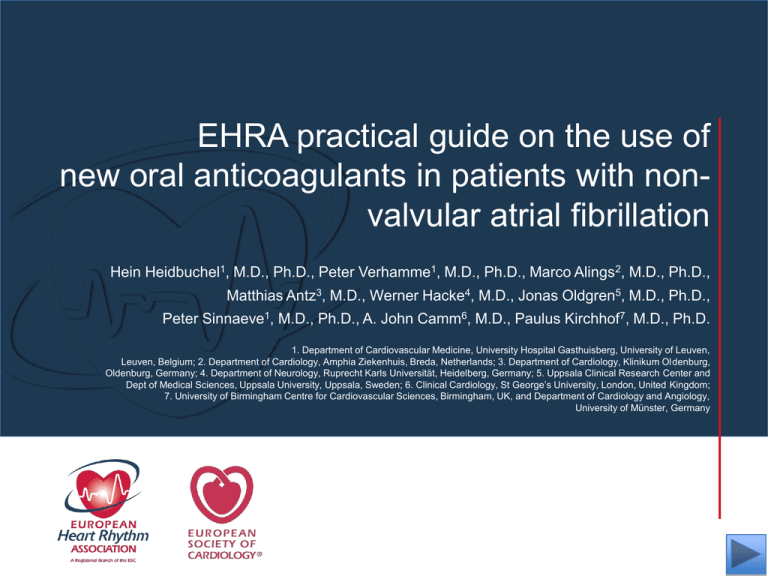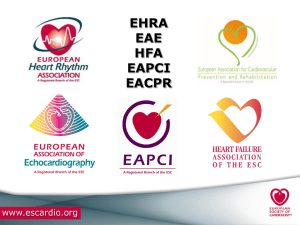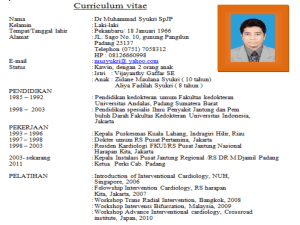
EHRA practical guide on the use of
new oral anticoagulants in patients with nonvalvular atrial fibrillation
Hein Heidbuchel1, M.D., Ph.D., Peter Verhamme1, M.D., Ph.D., Marco Alings2, M.D., Ph.D.,
Matthias Antz3, M.D., Werner Hacke4, M.D., Jonas Oldgren5, M.D., Ph.D.,
Peter Sinnaeve1, M.D., Ph.D., A. John Camm6, M.D., Paulus Kirchhof7, M.D., Ph.D.
1. Department of Cardiovascular Medicine, University Hospital Gasthuisberg, University of Leuven,
Leuven, Belgium; 2. Department of Cardiology, Amphia Ziekenhuis, Breda, Netherlands; 3. Department of Cardiology, Klinikum Oldenburg,
Oldenburg, Germany; 4. Department of Neurology, Ruprecht Karls Universität, Heidelberg, Germany; 5. Uppsala Clinical Research Center and
Dept of Medical Sciences, Uppsala University, Uppsala, Sweden; 6. Clinical Cardiology, St George’s University, London, United Kingdom;
7. University of Birmingham Centre for Cardiovascular Sciences, Birmingham, UK, and Department of Cardiology and Angiology,
University of Münster, Germany
Special Thanks to
Distributed through an educational grant from
Bayer
www.escardio.org/EHRA
EHRA Practical Guide on the use of new oral anticoagulants (NOAC)
in patients with non-valvular atrial fibrillation
•
This slide set is based on the following full text paper:
European Heart Rhythm Association Practical Guide on the use of new oral anticoagulants in
patients with non-valvularatrial fibrillation.
H. Heidbuchel; P. Verhamme; M. Alings; M. Antz; W. Hacke; J. Oldgren; P. Sinnaeve; A.J. Camm;
P. Kirchhof.
EP Europace 15: 625-651 (2013)
Published by Oxford University Press, May 15, 2013. doi: 10.1093/europace/eut083
http://www.ncbi.nlm.nih.gov/pubmed/23625942
•
An executive summary was published in:
European Heart Rhythm Association Practical Guide on the use of new oral anticoagulants in
patients with non-valvular atrial fibrillation. Executive Summary.
H. Heidbuchel; P. Verhamme; M. Alings; M. Antz; W. Hacke; J. Oldgren; P. Sinnaeve; A.J. Camm;
P. Kirchhof.
European Heart Journal 34: 2094-106 (2013)
Published by Oxford University Press, April 26, 2013
http://www.ncbi.nlm.nih.gov/pubmed/23625209
•
Updated information, downloadable anticoagulation cards, and possibility for feedback are
available via : www.NOACforAF.eu
The articles and related educational material (slide set, Web
page, Key Message booklet, …) were produced by and under
the sole responsibility of the
European Heart Rhythm Association, EHRA.
The project was funded by unrestricted educational grants
from the Alliance Bristol-Myers Squibb / Pfizer, Bayer
HealthCare Pharmaceuticals, Boehringer Ingelheim, and
Daiichi Sankyo Europe GmbH.
The EHRA writing committee collaborated with medical
experts from the different companies to assure data accuracy
and completeness.
www.escardio.org/EHRA
Advantages of new oral anticoagulants
(NOACs) over vitamin K antagonists (VKAs)
for thromboembolic prevention in patients
with non-valvular AF
• predictable effect without need for monitoring
• fewer food and drug interactions
• more predictable half-life/elimination
• improved efficacy/safety ratio
www.escardio.org/EHRA
1
Need for a practical guide
• 2010 ESC Guidelines (and the 2012 Update) do not
detail the NOAC in specific clinical situations.1,2
• Multiple physician tools supplied with each drug may be
confusing.
• EHRA has now produced a practical guide to
supplement AF guidelines.
1. Camm et al, Europace 2010;12:1360-420
www.escardio.org/EHRA
2
2. Camm et al, Eur Heart J 2012; 33:2719-47
NOACs approved or under evaluation for
prevention of systemic embolism or stroke in
patients with non-valvular AF
Action
Dose
Phase III clinical
trial
Dabigatran
Apixaban
Edoxaban *
Rivaroxaban
Direct thrombin
inhibitor
Activated factor
Xa (FXa) inhibitor
Activated factor
Xa (FXa) inhibitor
Activated factor
Xa (FXa) inhibitor
150 mg BID
5 mg BID
110 mg BID
2.5 mg BID
60 mg QD
30 mg QD
15 mg QD
ARISTOTLE 2
RE-LY 1
AVERROES
3
ENGAGE-AF 4
20 mg QD
15 mg QD
ROCKET-AF 5
* not yet approved by EMA
1. Connolly et al, N Engl J Med 2009; 361:1139-51
2. Granger et al, N Engl J Med 2011; 365:981-92
3. Connolly et al, N Engl J Med 2011; 364:806-17
www.escardio.org/EHRA
3
4. Ruff et al, Am Heart J 2010; 160:635-41
5. Patel et al, N Engl J Med 2011;365:883-91
1. Practical start-up and follow-up scheme for
patients on NOACs
• Risk/benefit analysis: is a NOAC indicated?
• When choosing a NOAC, consider co-medications taken by
patient.
• Consider co-medications such as PPI to reduce risk for
gastro-intestinal bleeding.
• Carry information card: generic card could serve for all NOACs.
• Need to educate patient on importance of strict adherence to
regimen – discontinuation is dangerous.
www.escardio.org/EHRA
4
EHRA proposal for a universal NOAC
anticoagulation card
Card can be downloaded in a printer-ready form or in a ppt format that can be configured to
the local language from www.NOACforAF.eu
www.escardio.org/EHRA
5
Need for structured follow-up
• All NOACs are anticoagulants and hence can cause serious
bleeding.
• All NOACs have some drug-drug interactions (DDIs).
• AF population is a fragile patient population.
• Patients should return for ongoing review according to a
predetermined schedule.
• Follow-up can be undertaken by specialist or GP with experience
in the field and/or appropriate secondary care physicians.
• Nurse co-ordinated AF clinics may be used. 1
1. Berti et al, Eur Heart J, 2013 (Epub ahead of print)
www.escardio.org/EHRA
6
Suggested
structured follow-up
www.escardio.org/EHRA
7
Checklist during follow-up of AF patients
on NOACs
Interval
Comments
Compliance
Each visit
Inspect remaining medication
Stress importance of compliance
Inform about compliance aids
Thrombo-embolism
Each visit
Cerebral, systemic and pulmonary circulation
Bleeding
Each visit
Side effects
Each visit
Co-medications
Each visit
“Nuisance” bleeding – prevention possible?
Bleeding with risk or impact on QoL – prevention possible? Need
to revise dose?
Continuation? Temporary cessation with bridging? Change of
anticoagulant drug?
Prescription or over-the counter drugs?
Even temporary use can be risky
Yearly
6-monthly
Haemoglobin, renal, liver function
Renal function if CrCl 30-60 ml/min or if on dabigatran and aged >75
years or fragile
3-monthly
on indication
If CrCl 15-30 ml/min
If intercurring condition may impact renal or hepatic function.
Blood sampling
www.escardio.org/EHRA
8
Follow-up: considerations
• Renal function: impaired renal function increases
plasma levels and hence anticoagulant effect of all
NOACs, especially dabigatran. Dose reduction may be
indicated.
• Minor bleeding: most is temporary and classified as
‘nuisance’. Discontinuation or dose reduction should
not be considered unless frequent and impacting on
patient’s QoL.
www.escardio.org/EHRA
9
2. How to measure the anticoagulant effect of
NOACs
Routine monitoring of coagulation not required, but quantitative
assessment of drug exposure may be needed in emergency
situations:
•
•
•
•
•
serious bleeding and thrombotic events
urgent surgery
renal or hepatic insufficiency
potential DDI
suspected overdosing
www.escardio.org/EHRA
10
Measuring the anticoagulant effect of NOACs
•
Important to know exactly when NOAC was administered relative to time
of blood sampling. Maximum effect at maximum plasma concentration
(~3h after administration).
•
Activated thromboplastin time (aPTT): qualitative assessment of
dabigatran, but sensitivity varies.
•
Diluted thrombin time (DTT): Hemoclot® suitable for quantitative
assessment of dabigatran but no data on cut off below which surgery
is safe.
•
Anti-FXa chromogenic assays: commercially available for quantitative
assessment, but no data to associate level with bleeding or thromboembolism risk.
www.escardio.org/EHRA
11
Measuring the anticoagulant effect of NOACs
Dabigatran
Apixaban
Edoxaban
Rivaroxaban
Plasma peak
2h after ingestion
1-4h post ingestion
1-2h after ingestion
2-4h after ingestion
Plasma trough
12-24h after ingestion
12-24h after ingestion
PT
cannot be used
12-24h after
ingestion
cannot be used
16-24h after
ingestion
prolonged: may
indicate excess
bleeding risk but
local calibration
required
INR
cannot be used
cannot be used
cannot be used
cannot be used
aPTT
at trough >2x ULN
suggests excess
bleeding risk
At trough >200ng/ml ≥
65s: excess bleeding
risk
n/a
cannot be used
prolonged but no known
relation with bleeding risk
cannot be used
cannot be used
cannot be used
cannot be used
no data yet
quantitative; no data on
threshold values for
bleeding or thrombosis
at trough >2x ULN:
excess bleeding risk
not affected;
cannot be used
not affected; cannot be
used
quantitative; no
data on threshold
values for bleeding
or thrombosis
not affected; cannot
be used
dTT
Anti-FXa assays
Ecarin clotting time
www.escardio.org/EHRA
12
prolonged but no known
relation with bleeding risk
Curvilinear relationship between aPTT and
dabigatran plasma levels
Van Ryn et al Thrombosis and haemostats 2010;103:1126-7
www.escardio.org/EHRA
13
Relation between PT and FXa inhibitor
(rivaroxaban) plasma levels
Douxfils et al Thromb Res. 2012;130:956-66
www.escardio.org/EHRA
14
3. Drug-drug interactions and pharmacokinetics of NOACs
Absorption and metabolism of NOACs
www.escardio.org/EHRA
15
Absorption and metabolism of NOAC
Dabigatran
Apixaban
Edoxaban *
3-7%
50%
62%
yes
no
no
66% (w/o food)
~100% with food
no
20%/80%
73%/27%
50%/50%
65%/35%
no
yes (elimination;
minor CYP3A4)
minimal (<4%
of elimination)
yes (elimination)
no effect
no effect
6-22% more
+39%
no
no
no official
recommendation yet
mandatory
Absorption with
H2B/PPI
plasma level -12 to
-30%
no effect
no effect
no effect
Asian ethnicity
plasma level +25%
no effect
no effect
no effect
dyspepsia 5-10%
no problem
no problem
no problem
12-17h
12h
9-11h
5-9h (young)/11-13h (elderly)
Bioavailability
Prodrug
Clearance:
non-renal/renal of
adsorbed dose if
normal renal function
Liver metabolism:
CYP3A4
Absorption with food
Intake with food?
GI tolerability
Elimination half-life
* not approved yet
www.escardio.org/EHRA
16
Rivaroxaban
Mechanisms underlying DDIs in NOACs
• P-glycoprotein transporter involved in absorption and renal
clearance – plasma levels may be affected by P-gp inducers
or inhibitors1
• Cytochrome P450 CYP3A4 involved in hepatic clearance of
rivaroxaban and apixaban – plasma levels may be affected
by CYP3A4 inducers of inhibitors2
1. Gnoth et al, J Pharmacol Exp Ther 2011;338:372-80
www.escardio.org/EHRA
17
2. Mueck et al, Br J Clin Pharmacol 2013
Action to be taken in case of DDIs
Three levels of alert:
• Red – contraindicated/not recommended for use
• Orange – adapt NOAC dose
–
dabigatran: 150 mg to 110 mg BID
–
rivaroxaban: 20 mg to 15 mg QD
–
apixaban:
5 mg to 2.5 mg BID
• Yellow – consider dose reduction if two concomitant yellow
interactions
• Where no data available, NOACs not recommended yet
www.escardio.org/EHRA
18
Possible drug-drug interactions –
Effect on NOAC plasma levels part 1
Atorvastatin
P-gp/ CYP3A4
Digoxin
P-gp
Verapamil
P-gp/ wk CYP3A4
Diltiazem
P-gp/ wk CYP3A4
Quinidine
Dabigatran
Apixaban
Edoxaban
Rivaroxaban
+18%
no data yet
no effect
no effect
no effect
no data yet
no effect
no effect
+12–180%
no data yet
+ 53% (slow release)
minor effect
no effect
+40%
No data
minor effect
P-gp
+50%
no data yet
+80%
+50%
Amiodarone
P-gp
+12–60%
no data yet
no effect
minor effect
Dronedarone
P-gp/CYP3A4
+70–100%
no data yet
+85%
no data yet
Ketoconazole;
itraconazole;
voriconazole;
posaconazole;
P-gp and BCRP/
CYP3A4
+140–150%
+100%
no data yet
up to +160%
Red – contraindicated; orange – reduce dose; yellow – consider dose reduction if another yellow factor present;
hatching – no data available; recommendation made from pharmacokinetic considerations
www.escardio.org/EHRA
19
Possible drug-drug interactions –
Effect on NOAC plasma levels part 2
Interaction
Fluconazole
Cyclosporin;
tacrolimus
Clarithromycin;
erythromycin
Dabigatran
Apixaban
Edoxaban
Rivaroxaban
CYP3A4
no data
no data
no data
+42%
P-gp
no data
no data
no data
+50%
+15–20%
no data
no data
+30–54%
P-gp/ CYP3A4
HIV protease
inhibitors
P-gp and BCRP/
CYP3A4
no data
strong increase
no data
up to +153%
Rifampicin;
St John’s wort;
carbamezepine;
phenytoin;
phenobarbital
P-gp and BCRP/
CYP3A4/CYP2J2
-66%
-54%
-35%
up to -50%
Antacids
GI absorption
-12-30%
no data
no effect
no effect
Red – contraindicated; orange – reduce dose; yellow – consider dose reduction if another yellow factor present;
hatching – no data available; recommendation made from pharmacokinetic considerations
www.escardio.org/EHRA
20
Factors associated with raised plasma levels of
NOACs part 3
Dabigatran
Apixaban
Edoxaban
Aged ≥ 80 years
Increased plasma level
no data
Aged ≥ 75 years
Increased plasma level
no data
Weight ≤ 60 kg
Increased plasma level
Renal function
Increased plasma level
Rivaroxaban
Pharmacodynamic interactions – antiplatelet drugs, NSAIDs
Systemic steroid therapy
Other increased
bleeding risk
Other anticoagulants
Recent surgery on critical organ (brain, eye)
Thrombocytopenia (e.g. chemotherapy)
HAS-BLED ≥ 3
Orange – reduce dose; yellow – consider dose reduction if another yellow factor present;
hatching – no data available; recommendation made from pharmacokinetic considerations
www.escardio.org/EHRA
21
4. Switching between anticoagulant regimens
VKA to NOAC
INR <2.0: immediate
INR 2.0–2.5: immediate or next day
INR >2.5: use INR and VKA half-life to estimate time to INR <2.5
Parenteral anticoagulant to NOAC:
Intravenous unfractioned heparin
(UFH)
Low molecular weight heparin (LMWH)
Start once UFH discontinued (t½=2h). May be longer in patients with renal
impairment
Start when next dose would have been given
NOAC to VKA
Administer concomitantly until INR in appropriate range
Measure INR just before next intake of NOAC
Re-test 24h after last dose of NOAC
Monitor INR in first month until stable values (2.0–3.0) achieved
NOAC to parenteral anticoagulant
Initiate when next dose of NOAC is due
NOAC to NOAC
Initiate when next dose is due except where higher plasma concentrations
expected (e.g. renal impairment)
Aspirin or clodiprogel to NOAC
Switch immediately, unless combination therapy needed
www.escardio.org/EHRA
22
5. Ensuring compliance with NOAC intake
Important – anticoagulant effect drops rapidly
after 12-24 h
• QD better adherence than BID for cardiovascular drugs in
general, but no data on superior dosing scheme for NOAC
in clinical practice.
• Patient education crucial: leaflets and instruction at
initiation, patient safety card, group sessions.
• Involve family members.
www.escardio.org/EHRA
23
Ensuring compliance with NOAC intake
• Nurse-co-ordinated AF centres to focus on compliance?
• Technological aids – medication boxes, smartphone apps.
• INR monitoring not needed/not useful.
• Involve pharmacy?
• If low compliance despite these, consider VKAs.
www.escardio.org/EHRA
24
6. How to deal with dosing errors
Missed dose:
BID: take missed dose up to 6 h after scheduled intake. If not possible
skip dose and take next scheduled dose.
QD: take missed dose up to 12 h after scheduled intake. If not
possible skip dose and take next scheduled dose.
Double dose:
BID: skip next planned dose and restart BID after 24 h.
QD: continue normal regimen.
Uncertainty about intake:
BID: continue normal regimen.
QD: take another dose then continue normal regimen.
Overdose:
Hospitalization advised.
www.escardio.org/EHRA
25
7. Patients with chronic kidney disease
Estimated t½ and AUC NOAC plasma concentrations compared to healthy controls
CrCl ≥ 60 ml/min
Dabigatran
Apixaban
Edoxaban
Rivaroxaban
~ 14 h 1
no data
~ 8.6 h 2
~ 8.5 h 3
CKD Stage I & II
CrCl 30–60 ml/min
(+44%)
~ 18 h 1
no data
~ 9.4 h 2
~9h3
CKD Stage III
CrCl 15–30 ml/min
(+52%)
~ 28 h
1
no data
~ 16.9 h
CKD Stage IV
CrCl ≤ 15 ml/min
2
~ 9.5 h 3
(+64%)
no data
no data
no data
no data
CKD Stage V
1. Stangier et al, Clinical pharmacokinetics 2010;49:259-68
3. Kubitza et al, Br J Clin Pharmacol 2010:70:703-2
www.escardio.org/EHRA
26
2. Ridout et al, J Clin Pharmacol 2009:49:1124
NOACs in renal dysfunction –
Approved European labels
Dabigatran
Apixaban
Edoxaban
Rivaroxaban
% of absorbed dose
renally excreted
80%
27%
50%1
35%
Bio-availability
3-7%
50%
62%2
66% without food
~ 100% with food
4%
14%
37%
33%
≥30 ml/min
≥15 ml/min
not available
≥15 ml/min
% of administered dose
renally excreted
Approved for CrCl
Label dosing
recommendation
CrCl ≥15 ml/min,
no adjustment
(i.e. 150 mg BID)
1. Ogata et al J Clin Pharmacol 2010;50:743-53
www.escardio.org/EHRA
27
Serum creatinine ≥1.5 ml/dl,
no adjustment
(i.e. 5 mg BID)
CrCl ≥ 50 ml/min,
no adjustment
(i.e. 20 mg QD)
2. Matsushima et al The AAPS Journal 2011;13:S2
NOACs in renal dysfunction –
Practical recommendations for dosing in chronic
kidney disease
Dabigatran
Apixaban
Edoxaban *
Rivaroxaban
When CrCl 30-49 ml/min, 150
CrCl 15-29 ml/min: 2.5 mg
not available
15 mg OD when CrCl
mg BID is possible (SmPC) but
BID is possible
110 mg BID if ‘high risk of
Serum creatinine ≥ 1.5 mg/dl
bleeding’ (SmPC) or
in combination with age ≥80
‘recommended’ (GL update)1
years or weight ≤60 kg
15-49 ml/min
(SmPC) or with other yellow’
Note: 75 mg BID approved in US
factor: 2.5 mg BID
only **
-if CrCl 15-30 ml/min
- if CrCl 30-49 ml/min
-and other orange factor (e.g.
verapamil)
* No EMA approval yet. Needs update after finalisation of SmPC ** No EMA indication. FDA recommendation based on pharmacokinetics.
Carefully consider benefits and risks of this approach Note that 75 mg capsules are not available in Europe for AF indication.
1. Camm et al, Eur Heart J 2012;33:2719-47
www.escardio.org/EHRA
28
NOACs in chronic kidney disease –
Clinical evidence
•
CKD a risk factor for both thrombo-embolic events and bleeding1,2
•
CrCl <60 ml/min may predict increased stroke and systemic embolism3
•
In Phase III trials, similar AUCs for reduced doses in patients with
decreased renal function as for higher dose in patients with normal
renal function4
•
Rivaroxaban approved for people with CKD stage IV, with lower dose
regimen, but should be used with caution: no trial data available in patients
with CrCl 15-30 ml/min
•
Low dose dabigatran (75 mg BID) approved by FDA but not EMA for
patients with severe renal insufficiency
1. Olesen et al, N Engl J Med 2012;367:625-35
2. Hohnloser et al, Eur Heart J 2012;33:2821-30
www.escardio.org/EHRA
29
3. Piccini et al, Circulation 2013;127:169-71
4. Mueck et al Clin Pharmacol 2011;50:675-86
NOACs in chronic kidney disease –
Practical suggestions
•
CKD should be considered an additional risk factor for stroke in AF but
CKD also increases bleeding risk
•
NOACs are a reasonable choice for anticoagulant therapy in AF
patients with mild or moderate CKD
•
NOACs similar benefit/risk ratio to VKAs with rivaroxaban (15 mg QD)
in renal impairment (CrCl <50 ml/min).1
With apixaban, there may be a lower relative bleeding risk 2
1. Fox et al, Eur Heart J 2011;32:2387-94
2. Hohnloser et al, Eur Heart J 2012;33:2821-30
www.escardio.org/EHRA
30
NOACs in chronic kidney disease –
Practical suggestions
•
Dabigatran may not be first choice as primarily cleared renally but may
be used in stable patients.
•
FXa inhibitors have 25-50% renal clearance therefore may be
preferred
•
Consider dose reductions in patients with CrCl <50 ml/min: apixaban
2.5 mg BID,1 rivaroxaban 15 mg/day2
•
Avoid NOACs in AF patients on haemodialysis: consider VKAs
1. Fox et al, Eur Heart J 2011;32:2387-94
2. Connolly et al N Engl J Med 2011; 364:806-17
www.escardio.org/EHRA
31
NOACs in chronic kidney disease –
Practical suggestions
•
Monitor renal function regularly and adapt the dose accordingly
•
Monitor renal function at the following intervals:
stage I-II (CrCl ≥ 60 ml/min)
yearly
stage III, elderly (>75 yrs) or frail patients on
6-monthly
dabigatran (CrCl 30–60 ml/min)
stage IV (CrCl ≤ 30 ml/min)
3-monthly
www.escardio.org/EHRA
32
8. What to do if there is a (suspected) overdose
without bleeding, or a clotting test is indicating
a risk of bleeding
• Acute recent ingestion of overdose: activated charcoal to
reduce absorption (standard dosing scheme for adults of
30 to 50 g).
• Consider coagulation tests to assess possible bleeding risk.
• In absence of bleeding, wait-and see approach.
www.escardio.org/EHRA
33
9. Management of bleeding complications
Possible measures to take in case of bleeding
part 1
Non life-threatening
Dabigatran
FXa inhibitors
Inquire last intake + dosing regimen
Inquire last intake + dosing regimen
Estimate normalization of haemostasis
Normalisation of haemostasis: ±24h
Normal renal function: ±24h
CrCl 50-80 ml/min: 24-36h
CrCl 30-50 ml/min: 36-48h
CrCl <30 ml/min: ≥48h
Maintain diuresis
Local haemostatic measures
Local haemostatic measures
Fluid replacement (colloids if needed)
Fluid replacement (colloids if needed)
www.escardio.org/EHRA
34
Possible measures to take in case of bleeding
part 2
Non life-threatening
Dabigatran
FXa inhibitors
RBC substitution if necessary
RBC substitution if necessary
Platelet substitution (in case of thrombocytopenia ≤ 60 x
Platelet substitution (in case of thrombocytopenia ≤ 60 x
109 /L or thrombopathy)
109 /L or thrombopathy)
Fresh frozen plasma as plasma expander (not as
Fresh frozen plasma as plasma expander (not as
reversal agent)
reversal agent)
Tranexamic acid can be considered as adjuvans
Tranexamic acid can be considered as adjuvans
Desmopressin can be considered in special cases
Desmopressin can be considered in special cases
(coagulopathy or thrombopathy)
(coagulopathy or thrombopathy)
Consider dialysis (primary evidence: - 65% after 4h)
Charcoal haemoperfusion not recommended (no data)
www.escardio.org/EHRA
35
Possible measures to take in case of bleeding
part 3
Life-threatening
Dabigatran
FXa inhibitors
All of the above
All of the above
Prothrombin complex concentrate (PCC) 25 U/g (may be
Prothrombin complex concentrate 25 U/kg (may be
repeated once or twice but no clinical evidence)
repeated once or twice but no clinical evidence)
Activated PCC 50IE/kg; max 200 IE/day: no strong data
Activated PCC 50IE/kg; max 200 IE/day: no strong data
about additional benefit over PCC. Can be considered
about additional benefit over PCC. Can be considered
before PCC if available
before PCC if available
Activated factor VII (rFVIIa; 90g/kg); no data about
Activated factor VII (rFVIIa; 90g/kg); no data about
additional benefit + expensive (only animal evidence)
additional benefit + expensive (only animal evidence)
www.escardio.org/EHRA
36
Possible measures to take in case of bleeding
Van Ryn et al Am J Med 2012;125:417
www.escardio.org/EHRA
37
10. Patients undergoing a planned surgical
intervention or ablation
Classification of surgical interventions according to
bleeding risk
Interventions not necessarily requiring discontinuation of anticoagulant
Perform procedures at ‘through’ levels of NOAC. Consider scheduling intervention
18-24 h after last intake and then restart 6 h later (i.e. skipping 1 dose with BID NOAC)
•
•
Dental interventions
•
Extraction of 1 to 3 teeth
•
Paradontal surgery
•
Incision of abscess
•
Implant positioning
Ophthalmology
•
Cataract or glaucoma intervention
•
Endoscopy without surgery
•
Superficial surgery (e.g. abscess incision, small dermatological excision)
www.escardio.org/EHRA
38
Classification of surgical interventions according
to bleeding risk
Low risk
High risk
•
•
Endoscopy with biopsy
Complex left-sided ablation: pulmonary vein
isolation, VT ablation
•
Prostate or bladder biopsy
•
Electrophysiological study or
•
Spinal or epidural anaesthesia; lumbar
diagnostic puncture
radiofrequency catheter ablation for
supraventricular tachycardia (including left
•
Thoracic surgery
sided ablation via single transseptal
•
Abdominal surgery
•
Major orthopedic surgery
•
Liver biopsy
•
Transurethral prostate resection
•
Kidney biopsy
puncture)
•
Angiography
•
Pacemaker or ICD implantation (unless
complex anatomical setting e.g. congenital
heart disease)
www.escardio.org/EHRA
39
When to stop NOACs before a planned surgical
intervention
Last intake of drug before elective surgical intervention
Dabigatran
Apixaban
Edoxaban *
Rivaroxaban
No important bleeding risk and/or local haemostasis possible: perform at trough level
(i.e. ≥12h or 24h after last intake)
Low risk
High risk
Low risk
High risk
CrCl ≥80 ml/min
≥24h
≥48h
≥24h
≥48h
CrCl 50–80 ml/min
≥36h
≥72h
≥24h
≥48h
CrCl 30–50 ml/min
§
≥48h
≥96h
≥24h
≥48h
CrCl 15–30 ml/min
§
not
indicated
not
indicated
≥36h
≥48h
CrCl <15 ml/min
Low
risk
no data
yet
no data
yet
no data
yet
no data
yet
High risk
Low risk
High risk
no data
yet
no data
yet
no data
yet
≥24h
≥48h
≥24h
≥48h
≥24h
≥48h
no data
yet
≥36h
≥48h
no official indication for use
*no EMA approval yet.; Low risk: surgery with low risk of bleeding. High risk: surgery with high risk of bleeding § many of these patients may be
on the lower dose of dabigatran (i.e. 2x110 mg/d) or apixaban (i.e. 2x2.5 mg/d), or have to be on the lower dose of rivaroxaban (15 mg/d).
www.escardio.org/EHR
A
40
When to restart NOACs after a planned surgical
intervention
Procedures with immediate and complete
Resume 6–8 h after surgery
haemostasis:
Atraumatic spinal/epidural anethesia
Clean lumbar puncture
Procedures associated with immobilization:
Initiate reduced venous or intermediate dose of
LMWH 6–8 h after surgery if haemostasis achieved.
Procedures with post-operative risk of
Restart NOACs 48–72h after surgery upon
bleeding:
complete haemostasis
Thromboprophylaxis (e.g. with LMWH) can be
initiated 6-8 h after surgery
www.escardio.org/EHR
A
41
Recommendations for stopping and starting
NOACs after AF ablation procedures
•
Limited available data. 1-5
•
Recommend strategy of bridging (with well-timed preoperative
discontinuation, as above: slide 40) and restarting of NOACs.
•
A too aggressively shortened periprocedural cessation of NOACs and/or
no bridging may be less safe when compared to continued VKA
administration and ablation under an INR between 2.0 and 3.0, both
concerning bleeding and cardioembolic complications.
1. Kakkireddy et al, J Am Coll Cardiol 2012; 59:1168-74
2. Kaseno et al, Circ J 2012; 76:2337-42
3. Snipelisky et al, J Interv Card Electrophysiol 2012; 35:29-33
www.escardio.org/EHRA
42
4. Winkle et al J Card Electrophysiol 2012; 23:264-8
5. Kim et al, Heart Rhythm, 2013 (ePub ahead of print)
11. Patients undergoing an urgent surgical
intervention
•
Discontinue NOAC.
•
Try to defer surgery at least 12 h and ideally 24 h after last dose.
•
Urgent surgery associated with much higher rates of bleeding than
elective procedures, but lower than VKA-treated patients. 1
•
Coagulation tests can be considered (classical test or specific tests) but
strategy based on these results has never been evaluated. Therefore
such strategy cannot be recommended and should not be used routinely.
1. Healey et al, Circulation 2012:126;343-8
www.escardio.org/EHRA
43
12. Patients with AF and coronary heart disease
Clinical evidence part 1
•
AF with ST-elevation (STE) or non ST-elevation (NSTE) ACS is associated with
higher mortality rates. 1
•
Thrombotic vs bleeding risk in published trials and cohorts influenced by
comorbidities and local practice.
•
Triple therapy with VKA doubles risk of bleeding complications compared with
clopidogrel +VKA. 2,3
•
Triple therapy with double antiplatelet drug therapy (DAPT) and NOACs at least
doubles bleeding risk after ACS. 4
•
Data from RE-LY trial suggests that the advantages of NOAC over VKA in dual or
triple therapy are preserved, but no comparative trial data to recommend one over
the other. 5
1. Lopes et al Eur Heart J 2009;30:2019-28
2. Sorensen et al, Lancet 2009; 374:1967-74
3. Lamberts et al Circulation 2012:126:1185-93 4. Mega et al, N Engl J Med 2012;366:9-19
www.escardio.org/EHRA
44
5. Dans et al Circulation 2013;127:634-40
Patients with AF and coronary heart disease
Clinical evidence part 2
•
No Phase III trial data available for evaluation of NOACs in patients with
recent ACS.
•
In a meta-analysis of dabigatran trials, small but significant increased rate
of MIs with dabigatran vs VKA (OR 1.33, 95% CI 1.03–1.71, p=0.03) but
without impact on overall net clinical survival benefit 1,2 No excess MI
observed in AF trials assessing FXa inhibitors.
•
After ACS, DAPT with apixaban increases major bleeding risk. 3
•
Low-dose rivaroxaban with DAPT improves ischemic outcome after ACS
but increased major bleeding risk.
1. Uchino et al, Arch Intern Med 2012;172:397-402
2. Hohnloser et al Circulation 2012;125:669-76
www.escardio.org/EHRA
45
3. Alexander et al, N Engl J Med 2011;365:699-7082
Scenario 1. Recommendations concerning
management of AF patients on NOACs who
present with an acute coronary syndrome (ACS)
part 1
•
Temporarily discontinue NOACs upon presentation
•
Initiate DAPT therapy unless frail with high bleeding risk
•
Administer low-dose aspirin (150–300 mg loading; 75–100 mg later) on admission,
preferably combined with ADP receptor inhibitor (ticagrelor or prasugrel preferred
over clopidogrel)
•
Initiate paraenteral anticoagulation (fondaparinux preferred)
www.escardio.org/EHRA
46
Scenario 1. Recommendations concerning
management of AF patients on NOACs who
present with an acute coronary syndrome (ACS)
part 2
In case of STEMI:
use primary PCI (radial approach) over fibrinolysis
• avoid UFH or enoxaparin until NOAC effect disappeared
In case of NSTE-ACS:
if not urgent, delay coronary angiography until waning of NOAC effect
• peri-procedural anticoagulation (UFH or bivalirudin preferred)
1. Uchino et al, Arch Intern Med 2012;172:397-402;
www.escardio.org/EHRA
47
2. Alexander et al, N Engl J Med 2011;365:699-708
Scenario 1. Recommendations concerning
management of AF patients on NOACs who
present with an acute coronary syndrome (ACS)
part 3
In case of PCI:
•
use radial approach
•
if indicated, balloon angioplasty without stenting
•
use bare metal stents
•
use additional paraenteral anticoagulation
•
periprocedural bivalirudin preferred. Discontinue immediately after PCI
•
avoid glycoprotein IIb/IIIa inhibitors unless bail-out situations
www.escardio.org/EHRA
48
Scenario 1. Recommendations concerning
management of AF patients on NOACs who
present with an acute coronary syndrome (ACS)
part 4
•
In patients requiring revascularization, bypass surgery may be preferred
in selected patients.
•
When restarting NOAC consider dose reduction according risk and aim
for shortest necessary duration of dual/triple therapy.
•
Newer platelet inhibitors prasugrel and ticagrelor have not been
evaluated for NOACs. Recommend awaiting further data before
combining these with NOACs.
www.escardio.org/EHRA
49
Scenario 2. Recommendations concerning new
onset AF in patients with a recent (<1y) ACS
part 1
•
In patients with low atherothrombotic risk, consider VKAs in monotherapy
after 1-3 months (6 months in case of recent DES), especially where
bleeding risk elevated (HAS-BLED ≥3).
•
In patients with high GRACE score (> 118), use additional single
antiplatelet therapy (clopidogrel preferred) in the first 6 to 12 months after
the acute event.
www.escardio.org/EHRA
50
Scenario 2. Recommendations concerning new
onset AF in patients with a recent (<1y) ACS
part 2
•
If NOAC indicated, consider FXa inhibitor (small and insignificant
increased risk of MI for dabigatran, but weigh against clinical benefit).
•
If dabigatran indicated, consider low dose (110 mg BID), in combination
with low-dose aspirin or with clopidogrel.
•
Ultra-low dose rivaroxaban in combination with DAPT has not been
evaluated in this setting and is not currently recommended.
www.escardio.org/EHRA
51
Scenario 3. Recommendations concerning new
onset AF in patients with a remote(>1 year ACS)
• Anticoagulation without additional antiplatelet agents is sufficient
for most AF patients with stable CAD.
• Advantages of NOACs over VKAs likely to be preserved: NOACs
may be safe and effective alternatives to VKAs. 1
• No preference given to any of NOACs.
• If using dabigatran, consider lower dose (110 mg BID) plus
low-dose aspirin (clopidogrel in case of allergy to aspirin). 2
1. Hohnloser et al, Circulation 2012;125:669-675;
www.escardio.org/EHRA
52
2. Dans et al Circulation 2013;127:634-40
13. Cardioversion in a NOAC treated patient
•
In patients with AF >48h duration undergoing cardioversion, oral
anticoagulants should have been given for at least 3 weeks before
cardioversion.
•
Continuous oral anticoagulation is mandatory for 4 weeks following
cardioversion.
•
Clinical trial data show no significant additional risk in patients treated with
NOACs vs. VKAs. 1
•
If NOAC compliance can be reliably confirmed, cardioversion should be safe.
•
If doubt about compliance, consider prior TEE. 2
1. Nagarakanti et al Circulation 2011;123:131-6;
www.escardio.org/EHRA
53
2. Piccini et al Circulation 2012;126:A19281
14. Patients presenting with acute stroke while
on NOACs
Acute haemorrhagic stroke
•
Discontinue NOACs.
•
Limited data to support use of aspecific procoagulants e.g. PCC, aPCC
and aFVII.
•
Use PCC or fresh frozen plasma as discussed in slides about measures
in case of major bleeding.
•
Same poor prognosis as for warfarin.
1. Hart et al. Stroke 2012;43:1511-7
www.escardio.org/EHRA
54
1
Patients presenting with acute stroke while
on NOACs
Acute ischaemic stroke
•
Assess the time window since last intake of NOAC: thrombolytic therapy
is associated with increased bleeding risk within 48h of last NOAC dose.
•
In case of uncertainty regarding last dose, prolonged aPTT (dabigatran)
or PT (FXa inhibitors) indicates that thrombolysis should not be given.
•
If NOACs have been given within 48h and coagulation tests not available
or abnormal, consider recanalization of occluded vessels.
www.escardio.org/EHRA
55
Stroke patients –
Management of post-acute phase
Haemorrhagic stroke
•
If cardioembolic risk high and risk of new haemorrhage low, restart NOACs
10-14 days after intracerebral haemorrhage.
•
For patients with low cardioembolic risk and high bleeding risk, carefully
consider reinintiation of NOACs: contraindicated unless bleeding risk has
been reversed.
•
Consider non pharmacological strategies instead of NOACs (e.g. ablation
or occlusion of the atrial appendage).
•
Mechanical thrombectomy without thrombolysis: no restrictions.
www.escardio.org/EHRA
56
Stroke patients –
Management of post-acute phase
Ischaemic stroke
•
If infarct size not expected to increase risk of secondary intracerebral bleeding,
re-initiate:
- in patients with TIA after 1 day
- small, non-disabling infarct after 3 days
- large infarcts not before 2 weeks
TIA of cardioembolic origin
•
•
•
(Re)start NOACs as soon as possible.
Bridging with LMWH not required.
In AF patients not suitable for VKAs, apixaban is superior to aspirin in stroke prevention. 1
1. Connolly et al, N Engl J Med 2011;364:808-17
www.escardio.org/EHRA
57
Stroke patients –
Management of post-acute phase
Ischemic stroke of cardioembolic origin
•
Initiation of NAOCs depends on infarct size and risk of new embolic stroke.
•
Bridging with LMHW not required.
•
Aspirin is not useful in secondary stroke prevention.
Patients with AF and significant carotid stenosis
•
Carotid endarterectomy and not stenting recommended to avoid triple therapy.
www.escardio.org/EHRA
58
15. NOACs vs VKAs in AF patients with a
malignancy
•
Patients with malignancies are at increased risk for thromboembolic
events: tumours may secrete prothrombotic factors or induce
inflammatory responses.
•
Cancer therapy inflicts bleeding risks through surgery, tissue damage
(irradiation) or myelosuppression.
•
Many malignancies are associated with increased risk of mucosal
bleeding.
•
Chemotherapy causes myelosuppression (leucopenia/ reduced platelet
count). This also reduces red blood cells and therefore reduces safety
margin in a bleeding event.
www.escardio.org/EHRA
59
NOACs in patients with cancer –
Practical suggestions part 1
•
Multidisciplinary care by cardiologist and oncologist.
•
When new anticoagulant initiation is needed, consider VKA over NOACs:
more clinical experience and reversal options, although INR is difficult to
manage.
•
Malignancy in patients with AF increases stroke risk.
•
If already on stable NOAC treatment: continue unless contraindications,
i.e. switch to VKA not mandatory.
www.escardio.org/EHRA
60
NOACs in patients with cancer –
Practical suggestions part 2
•
No additional anticoagulant therapy (e.g. LMHW) is needed if NOACs are
used.
•
In patients receiving moderately myelosuppressive therapies, NOACs
may be continued.
•
In patients undergoing tumour surgery, same principles apply as in
elective surgery.
•
Consider therapy-induced changes in organ function and adapt dose if
indicated.
www.escardio.org/EHRA
61
NOACs in patients with cancer –
Practical suggestions part 3
•
In patients undergoing myelosuppressive chemotherapy or radiation
therapy, consider temporary dose reduction or cessation of NOACs.
•
Monitor blood counts, bleeding signs and liver and renal function.
•
Consider gastric protection with PPI or H2 blockers in all patients treated
with NOACs.
•
Patients on NOACs should be instructed to monitor signs of bleeding
(petechiae, haemoptysis, black stools) and to contact therapy centre if
these develop.
www.escardio.org/EHRA
62
•
Special thanks to:
the Alliance Bristol-Myers Squibb / Pfizer
Bayer HealthCare Pharmaceuticals
Boehringer Ingelheim
Daiichi Sankyo Europe GmbH
•
Special thanks to:
AER (Arrhythmia & Electrophysiology Review) a Journal produced by Radcliffe
Cardiology ( Lifelong Learning for Cardiovascular Professionals) for their
contribution to the creation of this slide set
www.escardio.org/EHRA









